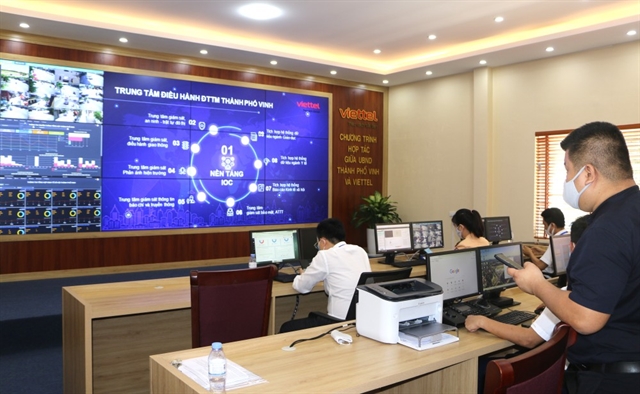 Economy
Economy


|
| The intelligent operation centre of Vinh City. The level and smart city implementation and development in provinces and cities across the country were improving significantly. — Photo baonghean.vn |
HÀ NỘI — Smart cities should be put into consideration from the urban planning stage to ensure synchronous development, Deputy Minister of Information and Communications Nguyễn Huy Dũng said.
Dũng spoke at the two-day Việt Nam Smart City Summit 2022, which opened on Thursday in Hà Nội. The event was held by the Vietnam Software and IT Services Association (VINASA). The deputy minister said smart city development was the implementation of digital transformation in the city scope with people being the centre.
The Government has raised policies to promote the development of smart cities to optimise resources, ensure sustainable development, protect the environment, ensure security and convenience for residents as well as accelerate socio-economic development.
The Prime Minister in August 2018 approved a project on sustainable smart city development in Việt Nam.
On November 11, the Government issued Resolution No 148 on an action plan to implement the Politburo’s Resolution 06 on planning, construction, management and sustainable urban development to 2030 with a vision to 2045.
The focus would be placed on restructuring the information technology infrastructure, forming shared platforms for urban areas, speeding up digital transformation in urban management and building e-Government toward digital Government.
As smart city development was a long-term process and required significant resources for implementation, it was important to include it in the overall urban planning to ensure synchronous development, Dũng said.
He pointed out that currently, localities mainly focused on developing and providing smart city services and utilities associated with e-Government and digital Government but did not pay adequate attention to planning and smart city management to solve fundamental problems of urban development including traffic, energy, and environment.
Thus, the efficiency in smart city development was not as high as expected in terms of improving the quality of life and the satisfaction of the people, he said.
Nguyễn Văn Khoa, VINASA’s President, said that Việt Nam had large potential and opportunity for smart city development. However, the biggest difficulty was the lack of a clear and transparent legal framework, especially in public-private partnerships and procedures for investment, bidding and IT services provision.
Moreover, urban areas had not paid attention to smart planning and basic infrastructure, Khoa said.
Nguyễn Nhật Quang, Director of the VINASA Science and Technology Institute, said it was important to develop requirements of smart cities for urban planning.
To date, 54 out of 63 provinces and cities were implementing smart city projects at different stages. 30 provinces and cities approved smart city development projects/programmes/plans, 15 approved ICT architecture for smart city development, 38 implemented provincial intelligent operation centres (IOCs), 21 implemented urban-level and municipal IOCs, 17 implemented apps for smart tourism services and more than 10 implemented apps for smart traffic, controlling and urban order. — VNS
Đà Nẵng honoured as the best smart city On the same day, VINASA presented Smart City awards to provinces and cities which strengthened the application of technology to smart urban management and the provision of services to people and enterprises. The central city of Đà Nẵng was honoured with the best smart city prize for three consecutive years since the award was launched in 2020. Other awards were presented to Đà Lạt (Lâm Đồng), Phổ Yên (Thái Nguyên), Đồng Xoài (Bình Phước) and Thừa Thiên Huế, Nguyễn Quân, president of the award’s council, said that the level and smart city implementation and development in provinces and cities across the country was improving significantly. According to Khoa, provinces and cities were in an important transition period along with the national digital transformation. — VNS |




